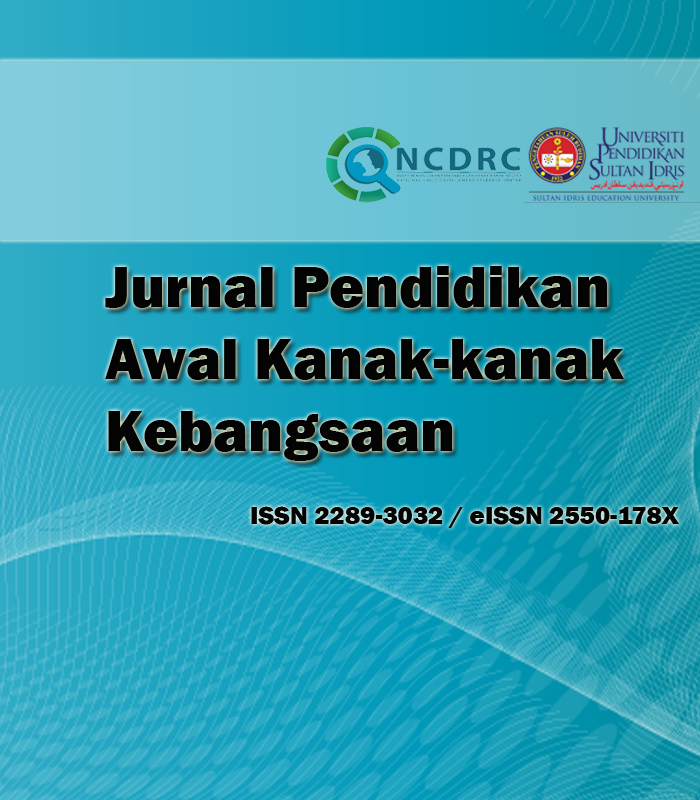Pengalaman mendengar dan membaca buku cerita moral sebagai pemangkin kecerdasan visual-ruang kanak-kanak prasekolah
Moral storytelling and story reading experience as a catalyst for preschool children's visual-spatial intelligence
DOI:
https://doi.org/10.37134/jpak.vol9.1.1.2020Keywords:
kecerdasan visual-ruang, lukisan kanak-kanak, penaakulan moral, emosi moral, kanak-kanak prasekolah, visual-space intelligence, children's painting, moral reasoning, moral emotion, preschool childrenAbstract
Kecerdasan visual-ruang menjadi asas untuk perkembangn dimensi kognitif, emosi dan tingkah laku kanak-kanak. Kecerdasan visual-ruang yang sering diinterpretasikan melalui lukisan kanak-kanak ini boleh ditingkatkan dengan memberikan pengalaman pembelajaran yang efisien di bilik darjah. Justeru, kajian ini dijalankan untuk meneroka pengalaman mendengar dan membaca buku cerita berunsurkan moral sebagai pemangkin kecerdasan visual-ruang kanak-kanak prasekolah. Kajian kualitatif ini dijalankan di sebuah sekolah tadika, di daerah Petaling Jaya, Selangor. Instrumen yang digunakan ialah dokumen (lukisan kanak-kanak), protokol pemerhatian, dan protokol temu bual. Seramai tujuh orang kanak-kanak prasekolah yang berumur lima hingga enam tahun dipilih sebagai peserta kajian secara persampelan bertujuan. Dapatan kajian menunjukkan pendekatan mendengar dan membaca buku cerita berunsurkan moral menjadi satu nilai tambah dalam menyokong kecerdasan visual-ruang kanak-kanak prasekolah. Dalam pada itu, lukisan kanak-kanak dapat digunakan untuk menilai kemahiran penaakulan moral, emosi moral dan perlakuan moral kanak-kanak prasekolah.
Visual-space intelligence forms the basis for developing children's cognitive, emotional and behavioral dimensions. Visual-space intelligence often interpreted through children's drawings can be enhanced by providing an efficient learning experience in the classroom. Therefore, this research aims to study the experience of listening and reading moral books as a catalyst for the visual-space intelligence of preschool children. This qualitative study was conducted at a kindergarten in Petaling Jaya, Selangor. The instruments used are, documents (children's drawings), observation protocols and interview protocols. A total of seven preschool children aged five to six years were randomly selected by purposeful sampling for data collection purposes. The findings show that the approach to listening and reading moral books is an added value in support the visual-space intelligence of preschool children. Children's drawing also can be used to assess the skills of moral reasoning, moral emotion and moral behaviour of preschool children.
Downloads
References
Clark, G., & Zimmerman, E. (1984). Educating artistically talented students. Syracuse UniversityPress.
Di Leo, J. H. (1983). Interpreting children’s drawings. Brunner/Mazel, Inc. https://doi.org/10.1080/09751122.2016.11890533
Escamilla Calan, I. M. (2015). Drawing, photographs, and painting: Learning about the natural world in an urban preschool.Voice of Practitioners, 10(2), 31-43.
Gallets, M.P. (2005). Storytelling and story reading: A comparison of effects on children’s memory and story comprehension. http://dc.etsu.edu/etd/1023
Gardner, H. (1994). The arts and human development. Basic Books.
Gunduz, N., & Ozcan, D. (2016). The development of Multiple Intelligence with Storytelling. International Journal of Educational Sciences, 15 (1-2), 242-251.
Hasibuan, N. (2017). The roles of Islamic education towards Islamic art and culture. Journal of Asian History, Culture and Tradition, 4(3), 27-35.
Ismail, H., Abdul, M. A., & Mohamad, I. (2019). The Islamic visual art education for social development of preschool children. Jurnal Pendidikan Awal Kanak-kanak Kebangsaan, 8, 1-7.
Lenz Taguchi, H. (2006). Reconceptualizing early childhood education: Challenging takenfor-granted ideas. Dalam J. Einarsdottir & J. Wagner (Eds.), Nordic childhoods and early education: Philosophy, research, policy, and practice in Denmark, Finland, Iceland, Norway, and Sweden(pp. 257–288). Information Age.
Li-Ming, L. (2007). The Relationships between creativity, drawing ability, and visual/spatial intelligence: A study of Taiwan’s Third-Grade children. Asia Pacific Education Review, 8(3), 343-352.
Mohd. Firdaus Che Yaacob, & Normaliza Abd. Rahim. (2014). Moulding children positive moral values through folklore. Journal of Business and Social Development, 2(2), 74-85.
Norjietta Julita Taisin. (2018). Aktiviti melukis meningkatkan keyakinan diri dalam kalangan kanak-kanak. Jurnal Pendidikan Awal Kanak-kanak Kebangsaan, 7, 19-29.
Ozyurek, A., Begde, Z., & Yavuz, N. F. (2014). The relation between the social skills of preschool education children and the adult interactions around. Social Sciences Journal, 16(2), 115-134.
Piaget, J. (1951). Play, dreams and imitation in childhood. Heinemann.
Tappan, M. (1990). Hermeneutics and moral development: Interpreting narrative representations of moral experience. Developmental Review, 10, 239-265.
Theodotou, E. (2017). Supporting personal and social development through child-led art projects in the early years settings. Early Child Development and Care, 189(11), 1889- 1900.
Wright, S. (2007). Graphic-narrative play: Young children’s authoring through drawing and telling. International Journal of Education & the Arts, 8(8), 1-28.
Yazici, E. (2017). The impact of art education program on the social skills of preschool children. Journal of Education and Training Studies, 5(5), 17-26.
Yazici, E., Yaman, B. I., & Pinarcik. O. (2016). A study into the views of preschool teachers over art. E-Journal of International Education Researches, 7(3), 74-88. doi: 10.19160/eijer.80596
Zoghi, N., Mohd Nor, M., & Abdul Hamid, F. (2018). Islamic patterns in Persian’s Herat School of Painting: A study on Baysonghori Shahnameh. Online Journal of Research In Islamic Studies, 5(3), 65-74.





